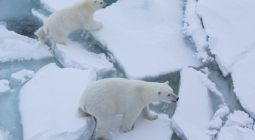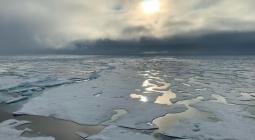Spoon worms lick the seabed with a metre-long tongue’: a voyage into a vanishing Arctic world
Sea ice around the north pole is disappearing at an alarming rate. A group of scientists are on a mission to investigate the effects of the climate crisis on the region
It is summer and the air temperature is just below freezing. Fog has crept in, blurring the outline of Polarstern, the German icebreaker moored to a kilometre-long ice floe at 85 deg N latitude. Next to a hole we have just drilled through 1.4 metres of ice, Morten Iversen, who studies the flow of carbon around the ocean, has attached several plastic containers to a rope secured by ice screws. They will be left hanging in the water under the ice for a day to catch marine snow – clumps of dead algae and zooplankton faeces that sink from the upper ocean to the deep sea.
A few metres away, a team of biologists perforate the ice floe with a core drill. They are looking for algae that grow at the bottom of sea ice, which play an important role in the Arctic Ocean food web. Metre-long ice cores are pulled up, packed in plastic sleeves and stacked on a sledge to be processed in the ship’s laboratories.
One of the scientists is keeping watch, with a rifle slung over her shoulder and a flare gun on her belt. This is, after all, a polar bear habitat – albeit a shrinking one.
Our group is part of a 100-strong expedition – half of them scientists, half ship’s crew – that set out from the Norwegian harbour of Tromsø in early August 2023 to investigate the rapid melting of the Arctic sea ice. The team is investigating the consequences for the marine ecosystem: from nutrient cycling to ice algae and plankton productivity to seafloor animal communities that live on organic material raining down from the surface ocean.
One of the scientists is keeping watch, with a rifle slung over her shoulder and a flare gun on her belt. This is, after all, a polar bear habitat – albeit a shrinking one.
The central Arctic is heating up much faster than most of the world. The area covered by sea ice in the Arctic Ocean at the end of summer has shrunk by about 40%, or 2.5m square kilometres – roughly the size of the Mediterranean Sea – since satellite observations began in the late 1970s. The remaining ice is getting thinner and multi-year floes – ice that has survived at least one summer – are becoming rarer. The waters around the north pole could be virtually free of ice at the end of the summer as early as the 2030s, according to a recent study.
Shrinking ice cover means not only the loss of hunting grounds of polar bears or resting places and nurseries for seals, but also of an entire under-ice ecosystem: meadows of filamentous ice algae, algae-grazing zooplankton, and juvenile polar cod, which find food and shelter in the cracks and crevices beneath the floes and, when grown up, feed larger predators such as ringed seals or beluga whales. In the short term, sea ice productivity could increase as more sunlight passes through thinner floes, boosting ice algae growth, but only as long as there is a sufficient supply of nutrients in the overall nutrient-poor central Arctic Ocean.
The same goes for planktonic algae, or phytoplankton, which profit from higher light availability and a longer growth season in the expanding open-water areas, as satellite data shows. Changes in productivity and a shift from ice algae to phytoplankton at the base of the food web will probably have major effects on the marine ecosystem as whole. Also, the native flora and fauna are facing new competition from invasive species, from plankton to fish, that are moving in from the Atlantic and Pacific as the oceans warm. Predictions of the future Arctic Ocean are, however, highly uncertain due to a general lack of observation. That is why the scientists have come here.
The chief scientist of the expedition, Antje Boetius, has been exploring the frigid waters of the Arctic for three decades. In summer 2012 her team witnessed the lowest sea-ice minimum on record, in the Arctic Ocean’s Eurasian Basin.
“Now, we are following the same route to repeat previous measurements on the ice-ocean system all the way down to the seabed,” says the deep-sea ecologist, who is also director of the Alfred Wegener Institute for Polar and Marine Research in Bremerhaven, Germany.
The ice-covered Arctic Ocean, especially its deeper realms, is one of the least explored regions on Earth. To catch a glimpse of larger creatures inhabiting the abyssal plains on the ocean floor and uncharted underwater mountains, the deep-sea ecologists have brought a camera system that is towed behind Polarstern.
The abundance and diversity of life in this cold, dark and food-scarce environment is truly astonishing: in places, large numbers of sea cucumbers and huge colonies of filter-feeding feather stars appear in the spotlights. We marvel at basketball-sized sponges flickering across the scientists’ screens, at apricot-coloured anemones and star-shaped patterns extending around the burrows of spoon worms, which lick the seabed for food particles with a metre-long tongue.
Polarstern regularly moors alongside large floes and part of the science team heads out on to the sea ice, pulling sledges heavily loaded with drilling tools and other equipment.
Flags on bamboo poles set up by a scouting party mark routes to different research sites. Meanwhile, the ship’s helicopter passes over them, with a torpedo-shaped sensor suspended below it that measures the thickness of the sea ice.
The rhythm of life onboard is determined by how fast the ship gets through the ice, the schedule for the research expeditions, and, most reliably, meal times: breakfast at 7.30am, lunch at 11.30am, coffee at 3.30pm, dinner at 5.30pm.
The scientists work around the clock, and often use any time off to catch up on sleep after a long night in the lab or outside on deck in freezing temperatures. Yet they still find time for social activities in the evenings, be it card games in the cosy red salon, water basketball in the ship’s swimming pool, or a pub quiz in the bar.
Although the sea ice coverage in the study area and in the Arctic Ocean overall is higher in 2023 than in previous years, the expedition makes good progress. We encounter thicker – but quite old and rotten – ice that Polarstern easily breaks through, and large gaps of open water between the floes.
And so, on 7 September, almost effortlessly, the ship reaches the northernmost point of the planet: the geographic north pole.
For most onboard, it is the first time; for Polarstern it is the seventh time. In 1991, with the Swedish ship Oden, it was the first conventional icebreaker to reach the latitude 90 deg N.
The Arctic Ocean has changed dramatically since that first arrival, says the captain, Stefan Schwarze. “Three decades ago, we needed two icebreakers to fight our way through the pack ice,” he says. “Today, we have reached the north pole with 30% of our engine power.”
Cover photo: Seascape: the state of our oceans





